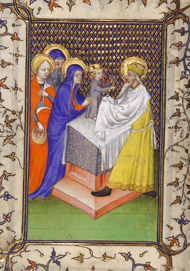|
This exhibition explores the role of textiles in medieval manuscripts.
Fabrics were luxury items, works of art, and even holy objects during the Middle Ages (about A.D. 500–1500). People handled manuscripts with cloths to preserve their metalwork or ivory covers. Manuscript makers often included textile fragments in bookbindings and sewed pieces of cloth onto the pages as protective "curtains." Manuscript illuminators also depicted clothing and textiles in their paintings to show the importance of the people and objects they represented. Christians believed that the image of Christ appeared miraculously on the cloth Saint Veronica used to wipe the sweat and blood from his face. Many pilgrims came to Rome to venerate this cloth, known as the sudarium. They also prayed to images of Veronica and the sudarium, such as the one shown above.
|
 |

 |
 |
The Ascension, Nicaea or Nicomedia, late 1200s
|
 |
 |
Small pieces of cloth often decorated and protected images in manuscripts.
A piece of blue silk once covered this scene of Christ ascending into heaven. The cloth is now gone, but the page retains the thread used to affix it.
This image comes from a Byzantine Gospel book that was lavishly illuminated and displayed on an altar. Its images, therefore, merited textile curtains.
|
 |
|
In the Middle Ages, costly fabrics made from luxurious materials and decorated with rich patterns were reserved for royalty, church ceremonies, and gifts to important individuals. Artists depicted these luxury fabrics in their paintings to convey the importance of their books and to glorify the word of God.
Byzantine silks were prized in Western Europe, particularly in Germany, where this manuscript was made. The purple pattern in the box containing text above Saint John's head imitates Byzantine textiles, serving as a splendid bearer of the words of the Gospel.
|
 |

 |
 |
The Presentation in the Temple, Pseudo-Jacquemart de Hesdin, about 1410
|
 |
 |
|
|
 |
Expensive textiles played a central role in royal and religious celebrations during the Middle Ages. Then, as now, they helped indicate the status and importance of people or objects.
Artists depicted textiles in manuscript paintings to glorify figures such as Christ. In this miniature, the rabbi, Simeon, covers his hands with his own garment to accept the Christ child. Simeon's action suggests that human hands are unfit to touch the Son of God.
|
 |
|
Medieval thrones were often low chairs with richly embroidered cloths hung behind them.
Charles the Bold (1433–1477), duke of Burgundy in central France, used fashion and rich fabrics to demonstrate the splendor of his court. Here he sits in front of a long strip of red fabric, which hangs from the ceiling by gold threads.
The luxurious fabric elevates the king above his crowd of attendants and focuses attention on the action.
|
 |
|
Curtains had many practical uses in the Middle Ages, as they do today. People hung fabric to decorate walls, divide up large spaces, and screen doorways. In manuscripts, curtains also expressed the concept of revelation, allowing access to depictions of Christ, Mary, or the Ark of the Covenant.
Here the angels kneeling in the corners pull back a curtain to reveal a sacred panel written in Hebrew, Greek, and Latin that loosely translates as, "Jesus of Nazareth, King of the Jews." This panel represents the sign that hung on the cross over Christ's head at his Crucifixion. The image encourages the reader to meditate on Christ's Crucifixion and Passion.
As in the other works in this exhibition, here textiles have both practical and symbolic value.
The exhibition is located at the Getty Center, Museum, North Pavilion.
|
 |